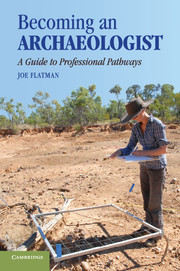Book contents
- Frontmatter
- Contents
- Tables and Figures
- Preface and Acknowledgments
- Introduction
- One What Is – and Isn't – Archaeology?
- Two Skills and Training
- Three Cultural Resource Management
- Four Academia
- Five Local Government
- Six Central Government
- Seven Public and Community Archaeology
- Conclusion
- Appendix 1 Useful Websites
- Appendix 2 Glossaries
- Appendix 3 Suggested Equipment to Take on an Archaeological Project
- References
- Index
Three - Cultural Resource Management
Published online by Cambridge University Press: 05 June 2012
- Frontmatter
- Contents
- Tables and Figures
- Preface and Acknowledgments
- Introduction
- One What Is – and Isn't – Archaeology?
- Two Skills and Training
- Three Cultural Resource Management
- Four Academia
- Five Local Government
- Six Central Government
- Seven Public and Community Archaeology
- Conclusion
- Appendix 1 Useful Websites
- Appendix 2 Glossaries
- Appendix 3 Suggested Equipment to Take on an Archaeological Project
- References
- Index
Summary
Introduction
What is meant here by cultural resource management (sometimes known as cultural heritage management [CHM]) are the archaeological jobs that are paid for directly as a consequence of the “polluter pays” laws and policies of different countries. Although the details, terms, legal status, and format of implementation vary widely (particularly issues of applicability on different types of land and the overlap of national/federal and local/state/county laws and regulations), the core principles of such policies tend to be the same. Ultimately, such principles are derived not from archaeology or even the wider historic environment lobby, but rather are modeled on the policies and principles in much longer use within the natural environment sector.
The principle has become enshrined in both common practice and legal statute in some, but by no means all, countries around the world that when developments such as the construction of houses and commercial buildings, transport, energy and other infrastructure, or extraction of primary resources such as minerals take place, then the historic environment, alongside the natural environment (i.e., flora and fauna), should be taken into consideration from the outset. This occurs for both firms undertaking development for profit or government, charity, or other organizations for the communal good – in some cases on all lands and properties irrespective of ownership, in other cases only on government-owned or -controlled lands, or on specific types of land such as Tribal or Indigenous-controlled land.
- Type
- Chapter
- Information
- Becoming an ArchaeologistA Guide to Professional Pathways, pp. 84 - 109Publisher: Cambridge University PressPrint publication year: 2011

